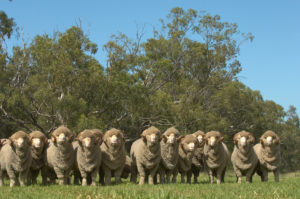For the past three seasons a combination of wet boggy conditions during winter and humid conditions during summer have given ewes and rams little reprieve from hoof issues and lameness. Hooves have been getting increasingly softer, having almost a rubbery consistency, with new tissue becoming easily damaged when walking. This is why hoof health management is so important.
As we move into the warmer part of the year environmental challenge is expected to increase, as a combination of humid and warm conditions provide an ideal environment for hooves to deteriorate and pathogens to thrive.
Hoof Health is Key to Performance
Although for some producers joining may be a distant job that they don’t want to think about yet, however, when managing hoof health intervention is recommended on a “the sooner the better” basis, especially after lambs have hit the ground.
To ensure that ewes and rams are fit for joining, Micheal Savli, Technical Manager at AusFarm Nutrition Products (ANP) emphasises the importance of performing regular hoof checks.

“Fourteen weeks from joining would be the best time to start looking at your breeding flock.”
“Get them in the yards and make sure you have a good look at their feet,” he said.
Hoof health was of particular concern last year, as persistent wet conditions saw a marked increase in reports of lameness in both ewes and rams.
“Lameness can reduce mobility and the inclination for a ram to serve and for ewes to be served.” Mr Savli said.
“On top of this, and less noticeable is the stress effect on both the ram and ewe, which can significantly reduce fertility.”
For both ewes and rams, the ideal time to get on top of lameness is fourteen weeks prior to joining so their hooves can begin to heal and harden up before getting put to work.
It also gives a good chance for producers to replace any with more serious hoof health issues that may not be responding to treatment.
Integrated Hoof Health Management
When managing hoof health and lameness, there are physical, chemical and nutritional control measures that have proven to be successful in different environments. With each control measure playing an important role, it is recommended to introduce an integrated program utilising all of these controls in order to get the best results.
Physical
Trimming nails and avoiding grazing of low lying, damp paddocks on the farm are good practices for reducing the disease pressure on sheep. It is important to pay special attention to heavier rams and multiple lamb bearing ewes whose hooves would most lively would have been under greater pressure throughout pregnancy. It is good practice to perform regular random hoof checks and, if possible, avoid boggy yards.
Similarly, effective shelter from wind and rain (trees, bushes, hills and large bales) can assist with keeping the sheep off their feed and reducing stress on the hooves.
Chemical
Foot bathing in zinc sulphate (10 to 20% solution) has been a common practice and successful for many years. It is recommended to perform bathing every few weeks in high challenge environments to manage infection and prevent the spread throughout the flock. The inclusion of lauryl sulphate (a wetting agent at 1 to 2%) has also been met with positive feedback from producers. See this interesting article on foot bathing.
Nutritional
Studies have shown significant value and success in effective mineral, vitamin and trace element supplementation when managing lameness. Mineral supplements can not only boost mineral status, animal health and immune response, but specific actives can also target healthy hoof growth and structure and assist in managing infections.
Choosing the Right Supplement
With many options in the market, Mr Savli stresses the importance of choosing an effective hoof health supplement like StockMins-Hoof n Horn.
“Hoof health management supplements can provide a high level of assistance when managing lameness, but the key is to include the right actives at the right levels to be effective.”
“Research has shown that that for the best results, supplements need to provide biotin at a consumption level of 5mg/hd/day and zinc consumption of at least 80mg/hd/day, with a large component of that zinc in organic form.1”
“These ingredients are expensive, especially when included at the levels that have been shown to yield results.”
“The most expensive inputs are ones that don’t work, so if there’s a cheap hoof health supplement out there, it is probably too good to be true.”
StockMins-Hoof n Horn is a high specification, weatherproof, granular loose-lick supplement designed to be fed to livestock to repair damage, fortify hooves and boost immunity during times of high production and stress.
On top of essential minerals, vitamins and trace elements, StockMins Hoof n Horn provides sheep with 5mg of biotin and 143mg of zinc per day which has been proven to improve hoof health since being launched by AusFarm Nutrition Products over ten years ago.
For more information on how StockMins-Hoof n Horn can help boost your flock performance this season, call the team at AusFarm Nutrition Products today. Contact Us
Jon Meggison 0412048055
References